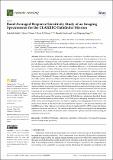Band-Averaged Response Sensitivity Study of an Imaging Spectrometer for the CLARREO Pathfinder Mission
Author(s)
Salehi, Fatholah; Thome, Kurtis; Wenny, Brian N.; Lockwood, Ronald; Wang, Zhipeng
Downloadremotesensing-14-02302.pdf (4.321Mb)
Publisher with Creative Commons License
Publisher with Creative Commons License
Creative Commons Attribution
Terms of use
Metadata
Show full item recordAbstract
Prelaunch absolute, SI-traceable radiometric calibration of satellite-based sensors is key to ensuring the utility of imaging spectrometer-based data products. The development of detector-based calibration techniques leads to the feasibility of meeting the 0.3% uncertainty level needed to provide climate quality data sets. Detector-based calibration is a method in which a well-understood and stable transfer radiometer is calibrated in a standards laboratory to SI-traceable standards, and transported to a facility calibrating a sensor of interest. The transfer radiometer provides the calibration of the source used in the radiometric calibration. A detector-based calibration approach is part of the prelaunch calibration of the CLARREO (Climate Absolute Radiance and Refractivity Observatory) Pathfinder (CPF) sensor with the Goddard Laser for Absolute Measurement of Radiance (GLAMR) system. The SI-traceability of GLAMR is through the electric watt as part of the absolute radiometric calibration of the detectors at the National Institute of Standards and Technology using the Primary Optical Watt Radiometer. The current work uses GLAMR data collected with a visible and near-infrared imaging spectrometer calibration demonstration system to develop a source/sensor modeled calibration data set as part of a sensitivity study to evaluate uncertainties from the spectral sampling and processing methods that accompany the GLAMR calibration process. The spectral “supersets” include realistic instrumental features as well as effects from the GLAMR source. The methods needed to ensure that spurious sensor and GLAMR data are excluded are described. Results are given from the sensitivity study related to GLAMR spectral sampling and signal-to-noise ratio (SNR) effects, sensor integration time, and frame averaging of the imaging spectrometer data. The study shows that the 6 nm bandwidth sensor simulation requires a 1 nm spectral sampling of the GLAMR source with a radiance level that provides an in-band peak SNR > 200 to ensure that climate quality accuracies can be achieved. The results are also used to refine the test plan for the independent calibration for the CLARREO Pathfinder sensor calibration to optimize test time while meeting the required accuracy levels.
Date issued
2022-05-10Department
Lincoln LaboratoryPublisher
Multidisciplinary Digital Publishing Institute
Citation
Remote Sensing 14 (10): 2302 (2022)
Version: Final published version